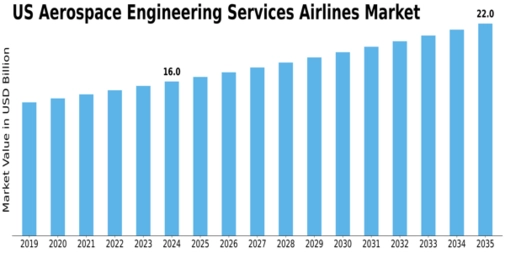The aviation industry has always been a symbol of progress, innovation, and precision engineering. In recent years, technological advancements, sustainability goals, and safety standards have all converged to redefine how aircraft are designed, maintained, and modernized. The US Aerospace Engineering Services Airlines Market is at the forefront of this evolution, supporting the industry’s push toward smarter, safer, and more efficient operations.
Engineering services in aerospace are vital to maintaining operational reliability, optimizing fleet performance, and ensuring compliance with evolving regulatory standards. From aerodynamic design improvements to system integration and lifecycle management, these services are shaping the future of U.S. airlines with data-driven innovation.
The US Aerospace Engineering Services Airlines Market plays a crucial role in aligning aircraft performance with the growing expectations of safety, sustainability, and digitalization. As airlines invest in modernization, engineering services provide the foundation for structural optimization, predictive maintenance, and next-generation system upgrades that enhance both passenger comfort and operational efficiency.
Market Growth and Industry Outlook
Recent market analysis indicates that the industry is witnessing steady growth, supported by advanced engineering software, digital modeling tools, and the integration of AI and automation in aircraft maintenance. These technologies allow engineers to identify potential faults before they occur, extending the lifespan of aircraft and improving flight safety.
Furthermore, the demand for sustainable aviation solutions is accelerating the adoption of lightweight materials, energy-efficient propulsion systems, and eco-friendly maintenance practices. As the market continues to evolve, aerospace engineering services are becoming an essential enabler of this transformation.
Key Trends in Aerospace Engineering
Emerging trends in aerospace engineering are reshaping the entire airline ecosystem. Digital twins and virtual simulation platforms are now being used to create accurate models of aircraft systems, helping engineers predict performance and optimize designs with unprecedented accuracy.
Additionally, 3D printing, advanced composites, and modular design approaches are streamlining production and reducing turnaround times for maintenance and retrofitting. The integration of robotics and real-time data analytics is improving maintenance accuracy, reducing operational downtime, and lowering lifecycle costs.
Market Size and Share Insights
The market size of aerospace engineering services in U.S. airlines continues to expand as carriers modernize fleets and invest in smarter maintenance frameworks. The share of digital services within this market has also grown rapidly, with predictive maintenance and performance analytics leading the way.
These advancements are not only enhancing operational performance but also redefining the relationship between airlines and engineering providers. Engineering services now serve as strategic partners in achieving long-term goals of efficiency, reliability, and sustainability.
Engineering Innovation and Operational Efficiency
Engineering innovation has become the backbone of operational efficiency in modern airlines. The shift toward integrated systems allows seamless data sharing between ground control, maintenance teams, and flight operations. This integration ensures that every aircraft operates at peak performance, minimizing unexpected delays and optimizing flight schedules.
Moreover, the focus on sustainability is driving the development of eco-friendly designs and maintenance practices. Aerospace engineers are continuously exploring ways to reduce waste, recycle materials, and optimize energy usage, all while maintaining high safety and performance standards.
Future Forecast for the US Market
The forecast for the US Aerospace Engineering Services Airlines Market shows significant transformation ahead. The future will likely see more automation, digital workflow adoption, and AI-driven diagnostics that enhance safety and maintenance precision. The integration of advanced analytics and cloud computing will further streamline communication between aircraft systems and ground control, ensuring faster decision-making and reduced downtime.
As the aerospace sector moves toward net-zero emissions, engineering services will play a critical role in integrating sustainable solutions into existing and future aircraft models. This includes the development of advanced aerodynamics, hybrid-electric propulsion systems, and digital monitoring platforms that improve environmental performance.
Why Engineering Services Are Critical for Airlines
- Safety and Compliance: Engineering services ensure all systems meet strict safety and regulatory standards.
- Efficiency: Optimization of design and maintenance processes improves turnaround and fuel efficiency.
- Innovation: Advanced technologies enable modernization without compromising reliability.
- Sustainability: Green engineering practices align with global environmental goals.
These benefits position engineering services as a cornerstone of the aviation industry’s next chapter of growth.
Conclusion
The US Aerospace Engineering Services Airlines Market stands as a pillar of modern aviation excellence. Through innovation, sustainability, and digital transformation, aerospace engineering services are empowering airlines to meet future challenges head-on. As new technologies continue to reshape design, maintenance, and operational strategies, these services will remain at the heart of aviation’s evolution — ensuring that the skies remain safer, cleaner, and more connected than ever before.
FAQs
1. What are aerospace engineering services in airlines?
They include design optimization, maintenance, system integration, and performance monitoring aimed at improving aircraft efficiency and safety.
2. What factors are driving the growth of the US Aerospace Engineering Services Airlines Market?
Advancements in digital tools, sustainability initiatives, and the demand for real-time maintenance solutions are the primary growth drivers.

